Cioppino is a comforting San Franciscan seafood stew filled with shrimp, clams, mussels, white fish, and crab legs all simmered in a rich broth made from tomatoes, white wine, and fish stock. A family favorite, enjoy this easy and delicious one-pot seafood stew for a special weeknight or holiday meal.
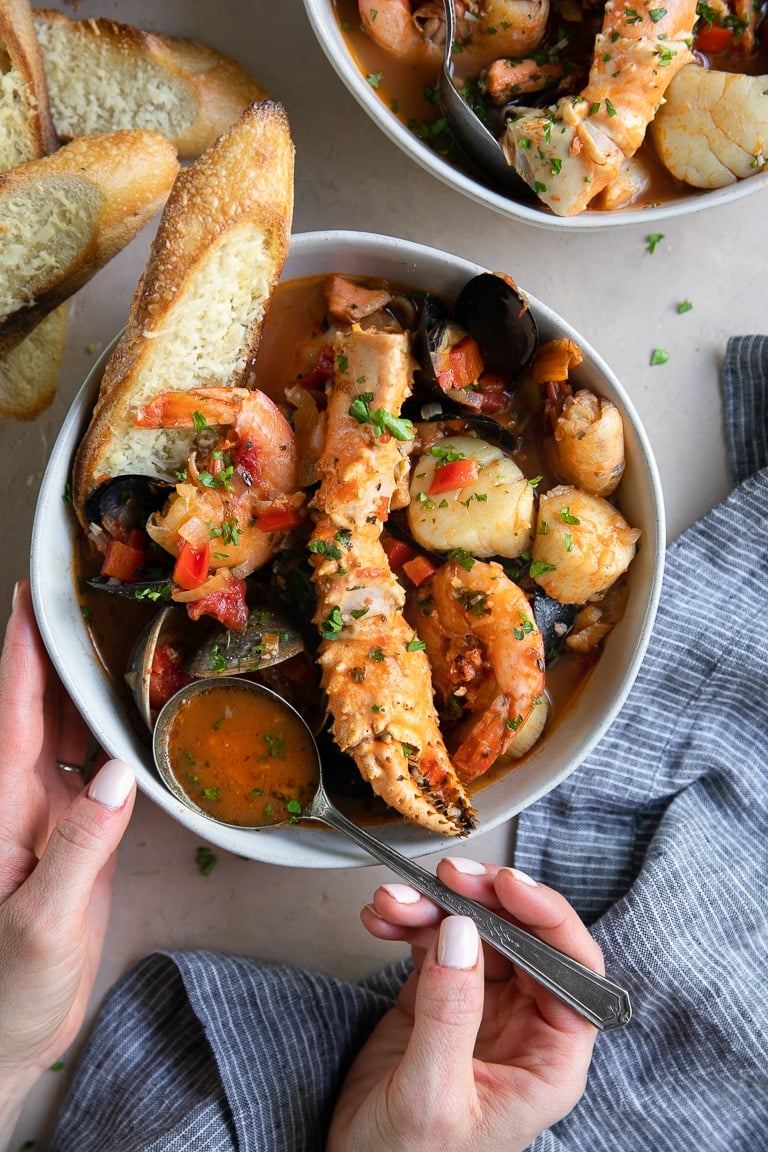
The Best Cioppino Recipe
Cioppino, or San Franciso fisherman’s stew, is my favorite stew recipe of all time.
If this is your first time hearing about it, then you are in for a treat because it is absolutely delicious – assuming, of course, that you like seafood (more on that in a minute).
Traditionally served with toasted garlic bread or freshly sliced baguette, my favorite way to enjoy this recipe is over a scoop of buttery mashed potatoes. A stew perfect for special occasions or holidays, cioppino is easily one of the best seafood recipes that you will ever make.
What is Cioppino?
Cioppino (pronounced Cho-pee-no) is an Italian-American dish originating in the 1880s in San Francisco.
Traditionally, cioppino would have been prepared with the day’s fresh catch. In San Francisco, this would include Dungeness crab, shrimp, sea scallops, squid, mussels, and fish commonly caught in the Pacific ocean. The seafood is then combined with a deeply flavorful broth made from tomatoes, fish stock, and white wine.
Cioppino comes from the word “ciuppin“, the name of a soup with similar flavors but prepared with less tomato and with Mediterranean seafood from Liguria, Italy.
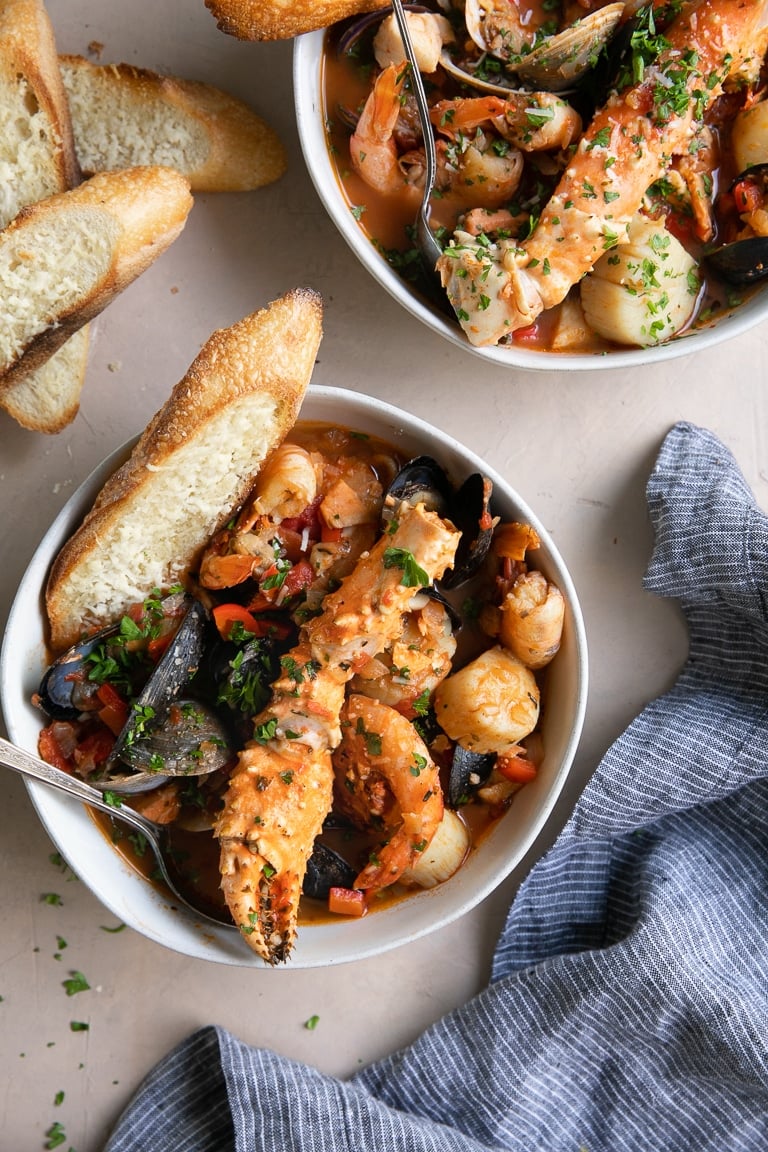
What is in Cioppino?
Originating in San Francisco, California, authentic cioppino recipes contain fish and seafood from the Pacific Ocean. This includes,
- Dungeness crab
- Shrimp
- Scallops
- Squid
- Calamari
- Clams
- Mussels
- Any fish found in the Pacific- halibut is a popular choice.
Feel free to keep your seafood stew simple by adding a few types of seafood (shrimp, halibut, and mussels, for example) or go all-out and get a little of each.
NOTE: I tried to keep this cioppino recipe as authentic as possible, but you’ll notice that I added some salmon to the pot. While salmon is also found in the Pacific, it isn’t as “popular” given that it isn’t a white fish.
Other non-seafood ingredients include:
- Olive oil
- Onions and/or shallots
- Red bell pepper
- Fresh garlic
- Dried Italian seasoning
- Red pepper flakes (optional)
- Tomato paste
- Dry white wine
- Crushed tomatoes
- Bay leaf
- Clam juice or Fish broth
Difference Between Cioppino and Bouillabaisse?
As we know, cioppino is made with a rich and comforting tomato-based broth. It comes filled with local “catch of the day” seafood native to the west coast of California. Most of the shellfish is often served in the shell.
Bouillabaisse, on the other hand, is a hearty French stew, much like cioppino, but it is unique in that it contains saffron. The broth, while it contains some tomatoes, is not considered a true tomato-based broth. Other defining characteristics include the use of Provençal herbs and spices, local Mediterranean fish, potatoes, and fennel.
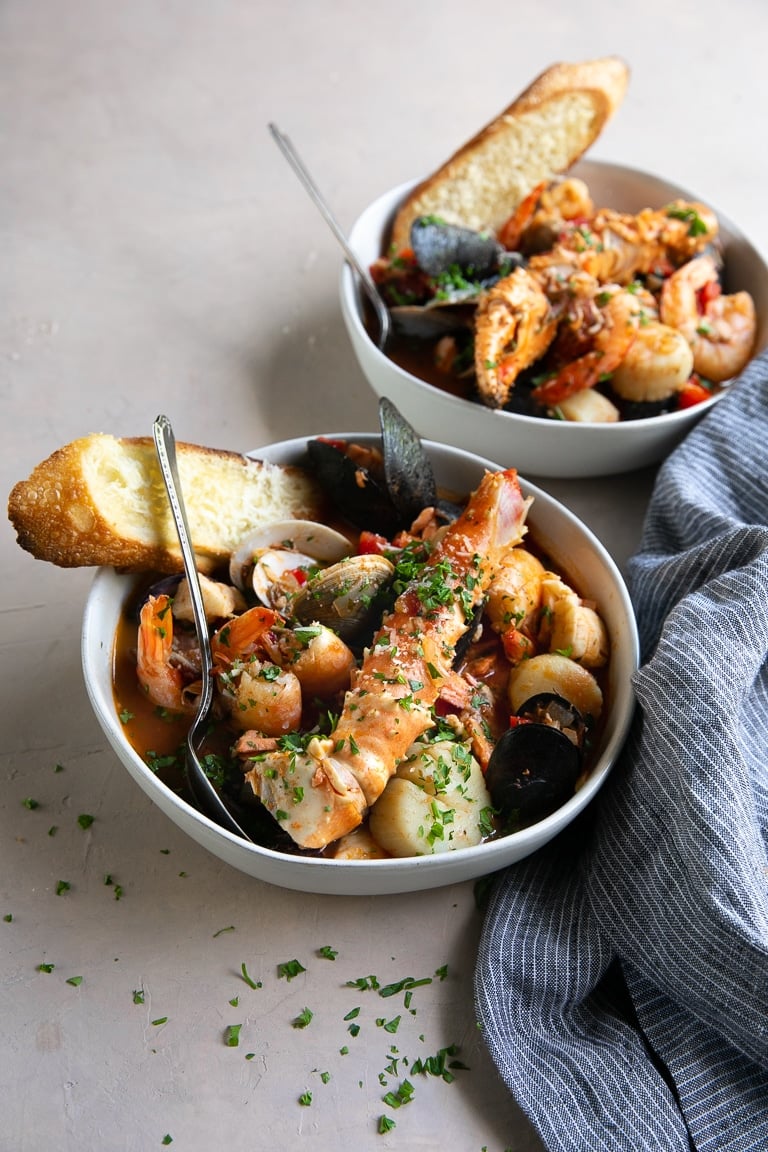
How to Make Cioppino
1. Cook the vegetables (mirepoix): Cook the onions and shallots in olive oil over medium-low heat. Cook them slowly so that they’re nice and soft- about 5 minutes or so. Add the diced bell pepper and continue to cook for an additional 5 minutes.
- TIP: Other popular veggies include chopped leek or fennel.
2. Add the wine and aromatics: Next comes the garlic, tomato paste, and finally the white wine. You really want each of these ingredients in your recipe (especially the wine), so unless you can’t have them for dietary reasons, I don’t recommend skipping them.
First, add the minced garlic and sauté for a minute or so. Mix them up really well with the onions and shallots before adding the oregano, Italian seasoning, salt, pepper, and crushed red pepper. Add the tomato paste. You’ll have to really mix it around to get it all mixed up with the onions. Stir continuously for 1-2 minutes before adding the wine. At least two cups.
3. Add the tomatoes (and lots of them): Increase heat to high. Bring the wine to a simmer and add the crushed tomatoes, bay leaf, and fish/clam broth. Bring to a low boil, and cover. Simmer for approximately 25 minutes.
- TIP: Here, at this point, you have your Cioppino stock. If you want to freeze it, do so now.
4. Add your favorite seafood: Once the Cioppino stock has been made, you can start adding the seafood. Start with the clams and mussels. Add them to the pot, cover them, and allow them to cook until the shells have opened (approximately 5-10 minutes). Next, add the calamari and white fish, cooking for 5 minutes before adding the scallops and the shrimp. Cover.
Cook for approximately 5-10 minutes.
Finally, add the crab legs. Since these are already cooked, you’ll only need to cook them until they are heated through.
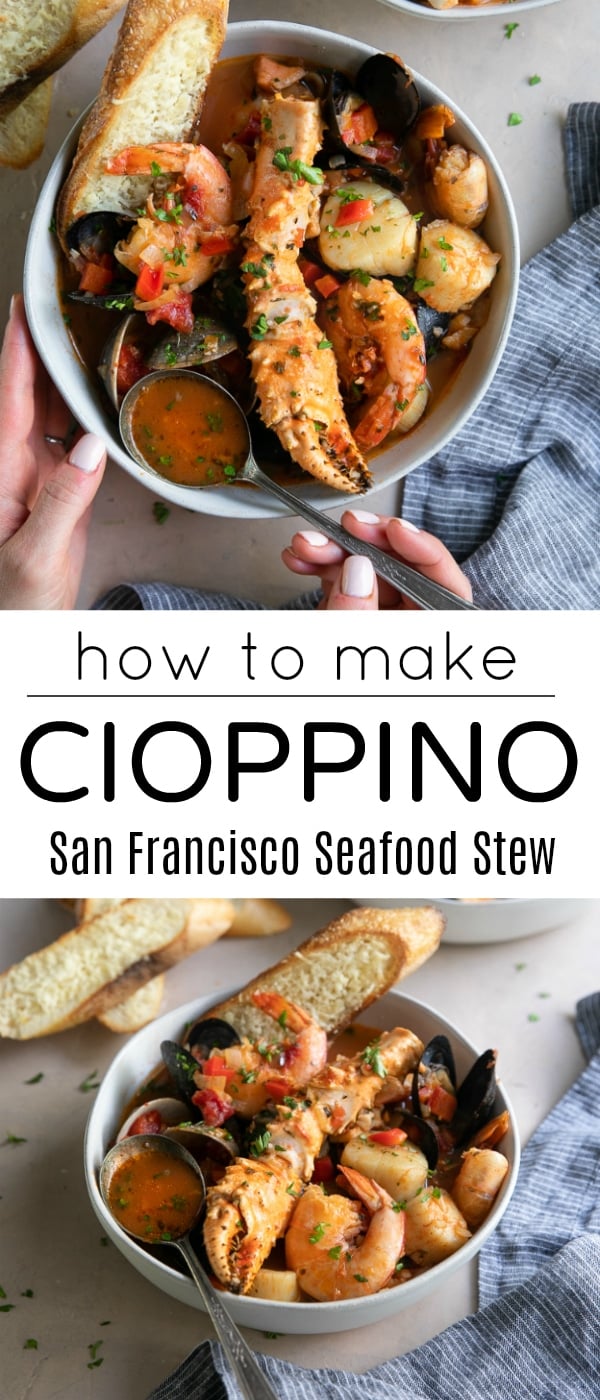
Storage and Freezing
I find that cioppino tastes better the next day, or even two days later. Some people may argue otherwise since fish, especially shrimp, tends to toughen up the longer it is cooked, and yes, in the case of shrimp, this is most definitely true. However, I find that the overall flavor only gets better two, even three days later.
Leftovers: For best results, I recommend only adding what you plan to eat right away, at least when it comes to the shrimp and calamari. However, everything else? The fish, scallops, clams, mussels – all good. Yes, the fish will flake apart, but that’s part of what makes the overall flavor of the broth that much richer the next day. Always reheat to a boil before serving and enjoy within 4 days.
Freezing: For best results, freeze before the addition of any seafood. Seafood that has been frozen, then cooked, then frozen, and then cooked again is not at its prime. So, freeze this recipe? Yes! But only freeze the stock/broth without any of the added seafood.
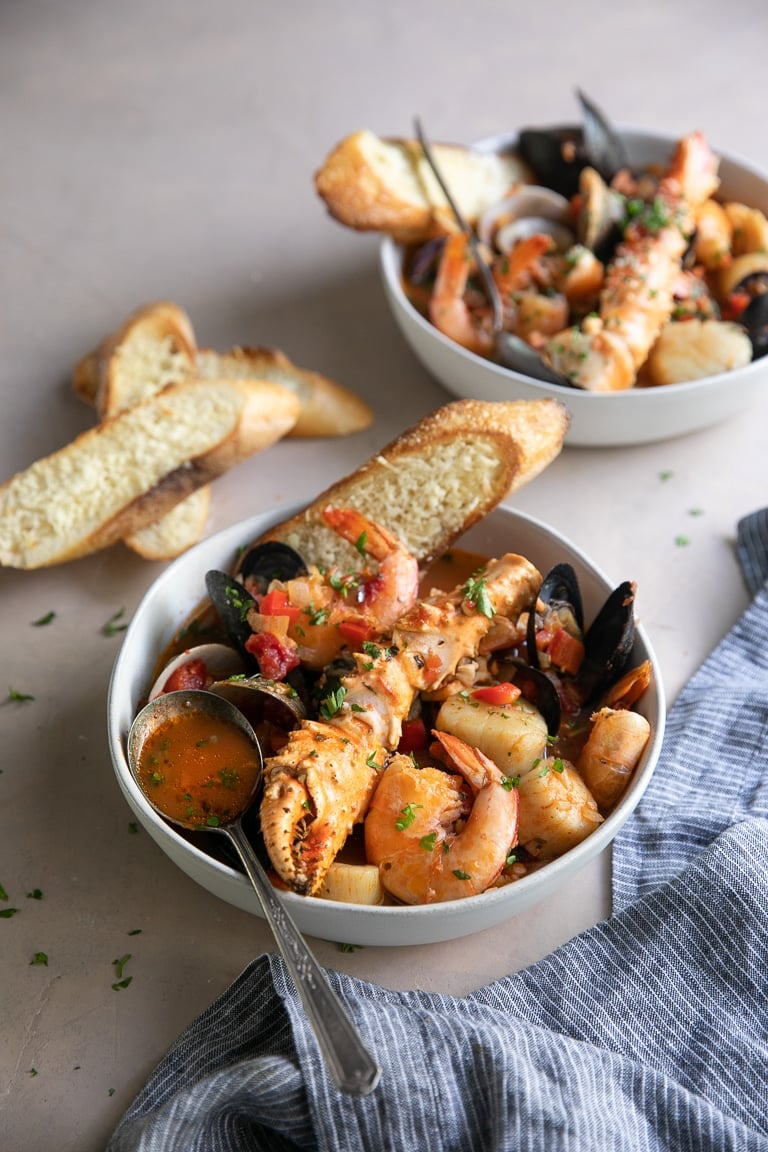
What to Serve with Cioppino
Cioppino is traditionally served with toasted garlic bread or freshly sliced baguette, however, I like to serve mine over a generous scoop of buttery mashed potatoes.
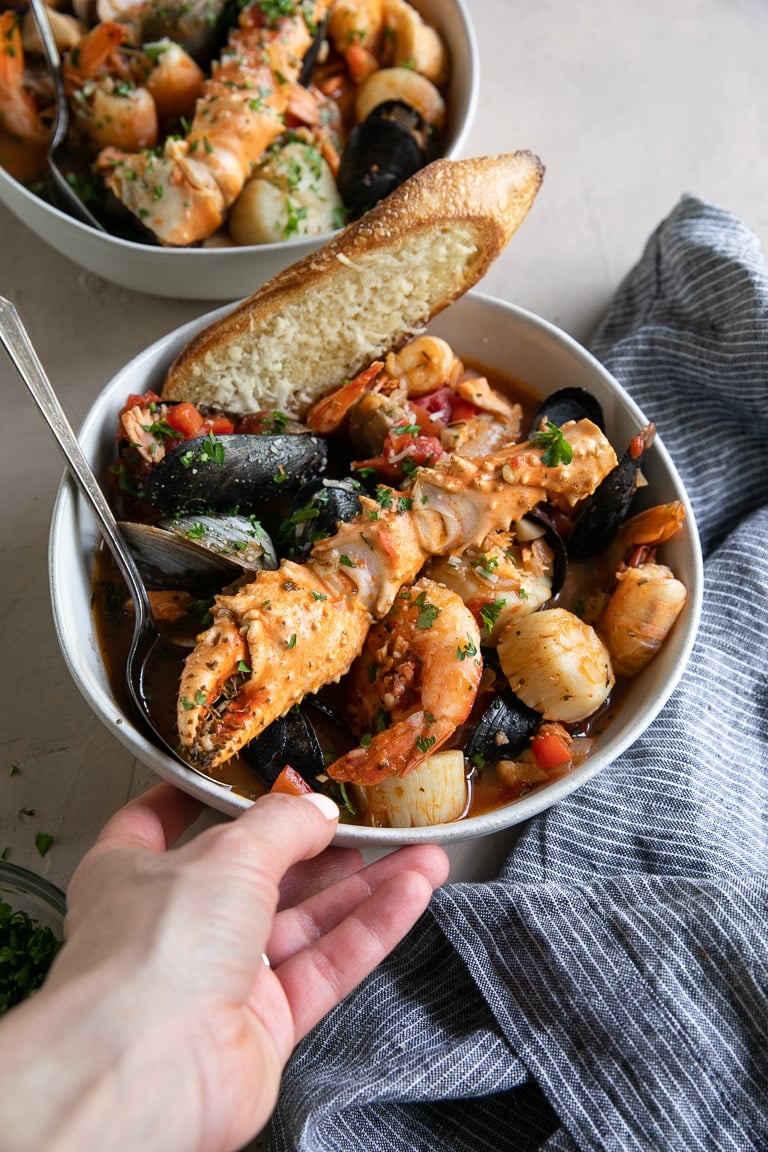
Have you tried this Cioppino Recipe?
Tell me about it in the comments below! I always love to hear your thoughts. And tag me #theforkedspoon on Instagram if you’ve made any of my recipes, I always love to see what you’re cooking in the kitchen.
RECIPE CARD
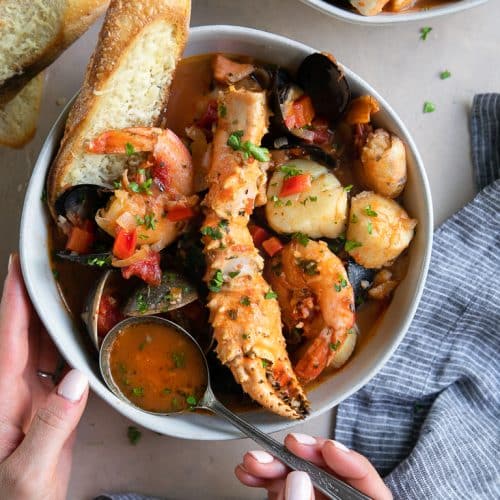
Cioppino Recipe (Seafood Stew)
Ingredients
- 2 tablespoon olive oil
- 1 large onion - chopped
- 3 shallots - chopped
- 2 red bell peppers - seeded and chopped
- 6 cloves garlic - chopped
- 1 teaspoon dried oregano
- 1 tablespoon Italian seasoning
- 1 teaspoon kosher salt - plus more to taste
- 1 teaspoon black pepper
- 1 teaspoon dried red pepper flakes
- ¼ cup tomato paste
- 2 cups dry white wine
- 1 (28 oz) can crushed tomatoes
- 1 bay leaf
- 30 oz clam juice or fish broth or seafood stock
- 1 lbs mussels - scrubbed, debearded
- 1.5 lbs littleneck clams - scrubbed
- ½ pound calamari
- 1.5 lbs halibut - or other firm-fleshed fish fillets, cut into 2-inch pieces
- 1 lb salmon
- ½ lb scallops
- 1 lb uncooked large shrimp - peeled and deveined
- 1 lb king crab legs
- Fresh flat-leaf parsley - chopped
Instructions
- Add the olive oil to a large heavy pot or Dutch oven set over medium heat. Add the onion and shallots and mix well to combine. Sauté for approximately 5 minutes, or until the onions start to soften and turn translucent. Stir often.
- Stir in the diced bell pepper and continue to cook for 4-6 minutes, stirring often.
- Add the garlic and cook for 1-2 minutes, stirring continuously, before adding the dried oregano, Italian seasoning, salt, pepper, and crushed red pepper. Mix well to combine.
- Mix the tomato paste with the cooked onions, stirring constantly to prevent burning. Allow the tomato paste to cook with the onions for 1-2 minutes.
- Increase to high heat and add the white wine, crushed tomatoes, bay leaf, and fish/clam broth. Mix well and bring to a low boil. Cover and reduce heat to low. Simmer for approximately 25 minutes.
- TIP: you may make this homemade tomato-based broth ahead of time. If you choose to make it ahead of time, stop cooking and store it in the refrigerator before adding any type of seafood.
- Still simmering, add the clams and mussels to the pot. Cover, and cook until the clams and mussels begin to open (approximately 5-10 minutes). Discard any clams and mussels that do not open. Add the calamari and fish and cook for 5 minutes, gently mixing to combine. Next, add the scallops and shrimp, and cook, covered, for 5 minutes. Last, add the crab legs to the pot and cook for 5 minutes, or until heated through.
- Season with additional salt and pepper, to taste, and garnish with fresh parsley and parmesan cheese, if desired. Serve with crusty bread (including sourdough bread or French bread), or mashed potatoes (not traditional, but amazing!) Enjoy!
Video
Jessica’s Notes
- You will need an extra-large pot or Dutch oven. I love this one from Le Crueset or this (more economical) version from Calphalon.
- If you would like to freeze Cioppino, I recommend freezing the broth before adding any fish or seafood.
- This recipe stores well in the refrigerator for up to 4 days.
- This is not a budget-friendly recipe. That said, it makes a huge pot of stew and will easily feed my husband and me for at least 4 nights. Save a few dollars and skip the fresh crab legs and jumbo sea scallops.
- Try to purchase sustainably caught seafood. If you’re unsure of the difference, ask your local fishmonger.
- Fresh seafood will result in the best-tasting seafood stew. If something doesn’t look fresh, swap it for something else.
- Traditional cioppino recipes are served with crab legs and other seafood left in their shells. Serve with a large collecting bowl for all the shells and plenty of napkins.
- If you prefer not to cook with white wine, substitute with additional fish broth or clam juice.
- Not sure where to find fish and clam broth? You can find each of these pantry essentials at most major supermarkets in the canned tuna or seafood section. I don’t have a preference, so in this case, I used one can of each clam and fish stock. You may also substitute with chicken or vegetable broth as a last resort.
Nutritional Information
(Nutrition information provided is an estimate and will vary based on cooking methods and specific brands of ingredients used.)

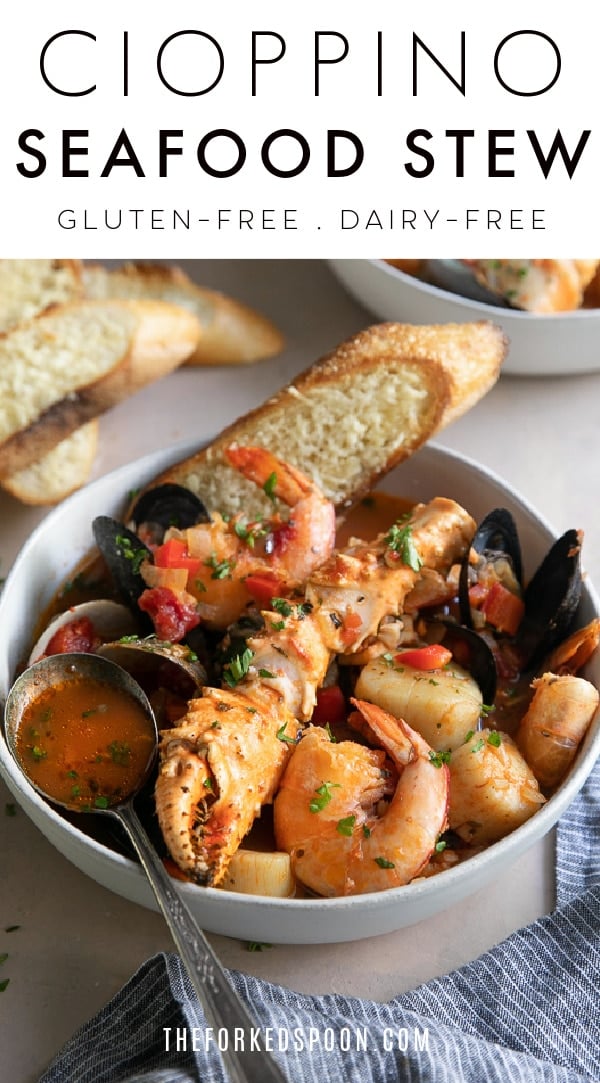



Thank you so much for your recipe. It was absolutely amazing and what I was looking to make for dinner. My mother in law and I loved it.
Made this for dinner tonight. It was so delicious! I did add a ton more garlic and used my emulsion blender in the base broth prior to adding seafood to smooth out the broth…amazing! Thank you! My husband is forever hook!
I have 2 questions: How long can I freeze the sauce? And my second question is: I have a bag of mixed, frozen seafood in my freezer. Can I use it in your recipe and, if so, should I thaw it out before adding it to the sauce? TIA!
2 months for freezing the stock.
This recipe is really about fresh seafood, I would stick to fresh if at all possible 🙂
So amazing! Thank you for sharing!
Hi Jessica!
I made this for Christmas Eve, and it was SO GOOD especially considering how easy it is to make. Quick question – I didn’t add clams or mussels, but should I have boiled the soup for the extra 10-15 minutes? Or is the soup base itself done before this step? I didn’t, but it still tasted fantastic – this is just out of curiosity because I was literally 50/50 on this decision lol.
Thanks for the feedback and rating Melanie, I am happy it was so good 🙂
The extra time would not be necessary in your case, but it didn’t hurt the Cioppino.
Happy new Year! Love making Cioppino, was looking for a new recipe!. This was great. My wife likes potatoes so I cooked up a few, you spice profile was great, neither of us like mussels so we had extra clams, I fried the scallops on the side, used sword fish and Halibut, lots of tomatoes were a good touch, paste was great (never used it in the past), and since I am in New England (lobster replace crab.) Asked my fish store for a 1.5 pounds, didn’t have it so she gave me 2 lb for the same price. People are great. Checked out your pialla recipe last night, next one to try. My wife and I wanted an all out cioppino tonight and we were not disappointed. Thanks J.
Happy New Years and thank you very much for the feedback Joe 😀
Are the crab legs raw or pre-cooked before adding them?
They are raw Jerry 🙂
This is a good recipe, and I have never animated it before!
Very similar to my grandmother’s recipe, she chops Swiss Card and adds to the broth it is almost my favorite part with a sour dough loaf of bread. Yummy
Thanks for the note on Swiss Card Kelly, I am going to have to try adding some on my next batch 🙂
Made this for dinner this evening and it was so yummy! Thank you for sharing the recipe!
Thanks for the kind feedback Jenn 🙂
Hi! This sounds absolutely delicious. You recommend serving with mashed potatoes. I was wondering how you do that. Do you add the mashed potatoes directly into your individual bowl of soup? Or do you served the mashed potatoes on the side and alternate bites? I’m eager to try it. Thank you!
Great question Mrs. Wolf! You can do it either way. On the side, or in the bowl before you add the stew is tasty as well 🙂
Enjoy
Gonna make for Christmas eve! Looked at many recipes and this one looks perfect! Feasr of the 7 fishes ♥️🎅🎄
Followed recipe except left out fennel, Great recipe, what great flavor.
HI !
I’ve got a question about the stock and re-heating etc.
You said that the taste the next day or even the second day is even better. Which I totally agree on.
So could I make the brought and leave that for a day so all the flavours really develop. And add all the fish the day I would like to eat it?
Or is it necessary for the taste to come into its own with the fish already added?
I’ve never made this before, but I’ve been looking into a lot of recipes the last couple of days about this dish. So I’m really excited about yours!
Thank you !
Kind Regards,
Romah
Hi,
Great question! I would recommend in this case cooking the salmon and white fish the day before and leaving all other seafood to cook the day of serving.
Hello from the Alaskan Mermaid
This is my most heartiest recipe and I have changed it a bit. Try 1 tsp. of Anchovy sauce or a fillet from can Anchovy, Fennel and bit of Saffron, not too much bay leaf since it will taste bitter. This recipe takes practise and knowledge of Seafood !!! Don’t forget before adding any Seafood, you can freeze or store the sauce in glass jar in Frig when you’re ready to have the dinner. White Dry Wine works excellent, but don’t overdue it.